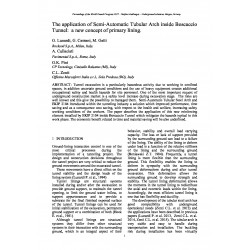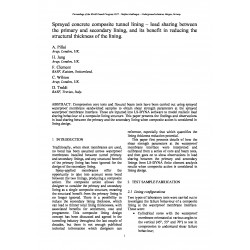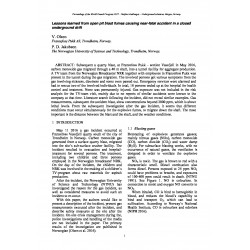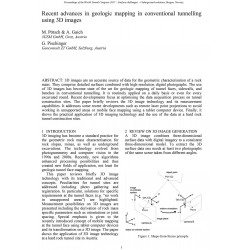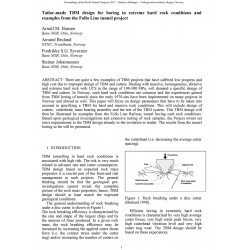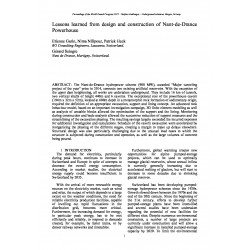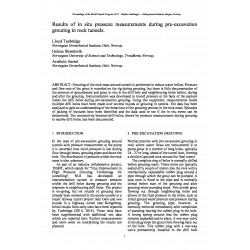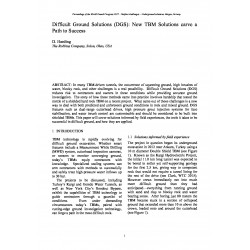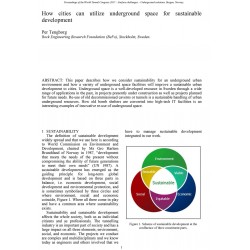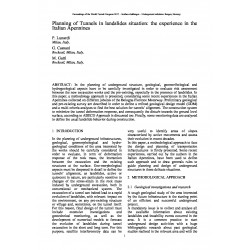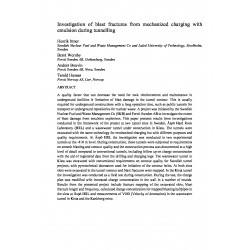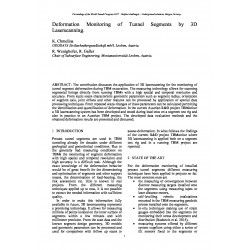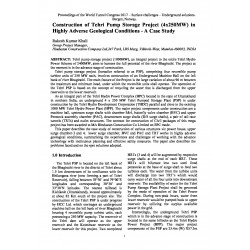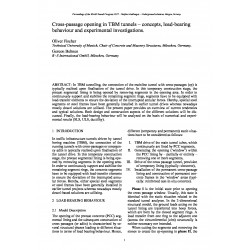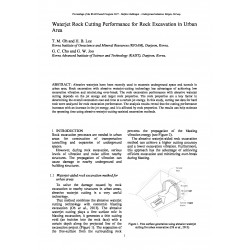No document
Search & filter
Search for a publication
Search & filter
Papers from WTC and ITA conferences have been made available as PDF documents.
ProceedingsThere are 1985 documents.
List of endorsed conferences
-
WTC
World Tunnelling Congress
-
The application of Semi-Automatic Tubular Arch inside Boscaccio Tunnel: a new concept of primary lining
Abstract: Tunnel excavation is a particularly hazardous activity due to working in confined spaces, in addition uncertain ground conditions and the use of heavy equipment creates additional occupational safety and health hazards for site personnel. One of the most important request of underground construction market is a safety level increase during excavation stage. The risks are well known and this...
0,00 € -
Sprayed concrete composite tunnel lining – load sharing between the primary and secondary lining, and its benefit in...
Abstract: Compression core tests and flexural beam tests have been carried out using sprayed waterproof membrane sandwiched samples to obtain shear strength parameters at the sprayed waterproof membrane interface. These are inputted into LS-DYNA software to model realistic load sharing behaviour of a composite lining structure. This paper presents the findings and observations in load sharing between the...
0,00 € -
Lessons learned from open pit blast fumes causing near-fatal accident in a closed underground drift
Abstract: Subsequent a quarry blast, at Franzefoss Pukk - section Vassfjell in May 2016, carbon monoxide gas migrated through a 40 m shaft, into a tunnel facility for aggregate production. A TV team from the Norwegian Broadcaster NRK together with employees in Franzefoss Pukk was present in the tunnel during the gas migration. The involved persons got various symptoms from the gas involving sickness,...
0,00 € -
Recent advances in geologic mapping in conventional tunnelling using 3D images
Abstract: 3D images are an accurate source of data for the geometric characterisation of a rock mass. They comprise detailed surfaces combined with high-resolution digital photographs. The use of 3D images has become state of the art for geologic mapping of tunnel faces, sidewalls, and benches in conventional tunnelling. It is routinely applied on a daily basis or even for every excavated round. Recent...
0,00 € -
Tailor-made TBM design for boring in extreme hard rock conditions and examples from the Follo Line tunnel project
Abstract: There are quite a few examples of TBM projects that have suffered low progress and high cost due to improper design of TBM and cutters. Dealing with massive, homogeneous, abrasive and extreme hard rock with UCS in the range of 100-300 MPa, will demand a specific design of TBM and cutters. In Norway, such hard rock conditions are common and the experiences gained from TBM boring of tunnels since...
0,00 € -
Lessons learned from design and construction of Nant-de-Drance Powerhouse
Abstract: The Nant-de-Drance hydropower scheme (900 MW), awarded "Major tunneling project of the year" prize in 2014, connects two existing artificial reservoirs. With the exception of the upper dam heightening, all works are undertaken underground. They include 16 km of tunnels, two vertical shafts of height 440m and 6 caverns. The exceptional size of the powerhouse cavern (194m x 32m x 52m), located at...
0,00 € -
Results of in situ pressure measurements during pre-excavation grouting in rock tunnels
Abstract: Grouting of the rock mass around tunnels is performed to reduce water inflow. Pressure and flow-rate of the grout is recorded on the rig during grouting, but there is little documentation of the pressure of groundwater and grout in situ in the drill hole and neighbouring holes before, during and after the grouting. Instrumentation was developed to record pressure at the back of the packers...
0,00 € -
Difficult Ground Solutions (DGS): New TBM Solutions carve a Path to Success
Abstract: In many TBM-driven tunnels, the occurrence of squeezing ground, high inrushes of water, blocky rock, and other challenges is a real possibility. Difficult Ground Solutions (DGS) reduces risk to contractors and owners in these conditions while providing accurate ground investigation. The story of how these methods came into practice involves hardship that tested the mettle of a shielded hard...
0,00 € -
How cities can utilize underground space for sustainable development
Abstract: This paper describes how we consider sustainability for an underground urban environment and how a variety of underground space facilities will improve a sustainable urban development to cities. Underground space is a well-developed resource in Sweden through a wide range of applications in the past, in projects presently under construction as well as projects planned for future needs. Re-use...
0,00 € -
Planning of Tunnels in landslides situation: the experience in the Italian Apennines
Abstract: In the planning of underground structure, geological, geomorfhological and hydrogeological aspects have to be carefully investigated in order to evaluate risk assessment between the new excavation works and the pre-existing, especially in the presence of landslides. In this paper, a methodology approach is presented, considering some recent experiences in the Italian Apennines collected on...
0,00 € -
Investigation of blast fractures from mechanized charging with emulsion during tunnelling
Abstract: A quality factor that can decrease the need for rock reinforcement and maintenance in underground facilities is limitation of blast damage in the tunnel contour. This is usually required for underground constructions with a long operation time, such as public tunnels for transport or underground repositories for nuclear waste. A project was initiated by the Swedish Nuclear Fuel and Waste...
0,00 € -
Deformation Monitoring of Tunnel Segments by 3D Laserscanning
Abstract: The contribution discusses the application of 3D laserscanning for the monitoring of tunnel segment deformation during TBM excavation. The measuring technology allows for scanning segmental linings directly from running TBMs with a high spatial and temporal resolution and accuracy. From static scans characteristic geometric parameters such as segment radius, orientation of segment axis, joint...
0,00 € -
Construction of Tehri Pump Storage Project (4x250MW) in Highly Adverse Geological Conditions - A Case Study
Abstract: Tehri pump storage project (1000MW), an integral project to the entire Tehri Hydro Power Scheme of 2400MW, aims to harness the full potential of the river Bhagirathi. The project at the moment is in the advance stage of construction. Tehri pump storage project (hereafter referred to as PSP), comprising four reversible pump turbine units of 250 MW each, involves construction of an Underground...
0,00 € -
Protection of Adjacent Buildings Due to Mixshield Tunnelling in Mixed Ground with Round Gravel and Mudstone
Abstract: The micro-disturbed construction in mix ground is a major challenge in the shield tunnelling construction. The Nanning metro line 1 crossing a mass of buildings is confronted with the challenge of round gravel and mudstone. The settlement control scheme consisting of the selection of TBM, tunnelling parameters optimization was put forward before crossing the buildings. Then the mix proportion...
0,00 € -
Cross-passage opening in TBM tunnels – concepts, load-bearing behaviour and experimental investigations
Abstract: In TBM tunnelling, the connection of the mainline tunnel with cross-passages (cp) is typically realised upon finalisation of the tunnel drive. In this temporary construction stage, the precast segmental lining is being opened by removing segments in the opening area. In order to continuously support and stabilise the remaining segment rings, segments have to be equipped with load-transfer...
0,00 € -
Waterjet Rock Cutting Performance for Rock Excavation in Urban Area
Abstract: Abrasive waterjets have been recently used to excavate underground space and tunnels in urban area. Rock excavation with abrasive waterjet-cutting technology has advantages of achieving low excavation vibration and minimizing over-break. The rock excavation performance with abrasive waterjet cutting depends on the jet energy and target rock properties. The rock properties are a key factor in...
0,00 €


